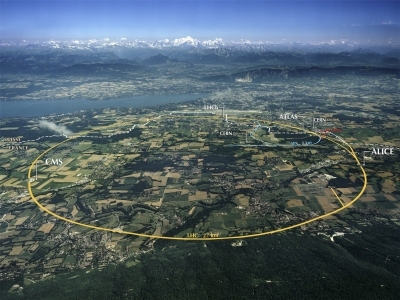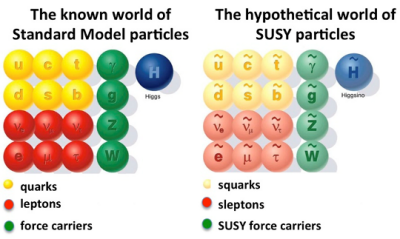The most popular scenario for physics beyond the Standard Model is Supersymmetry. Supersymmetry is a fermion-boson symmetry which provides a dark matter candidate naturally and which explains the stability of the Higgs mass.
Mariana Frank Research Group
Most of our work is devoted to the prediction, anticipation, and explanation of new signals coming from various accelerators, in particular, from the Large Hadron Collider (LHC), in particular, to specialized searches of Physics Beyond The Standard Model of electroweak interaction. These searches are motivated by the fact that the Standard Model, while experimentally successful, still suffers from theoretical inconsistencies, and it does not explain all phenomena observed in nature (such as, for example, dark matter).
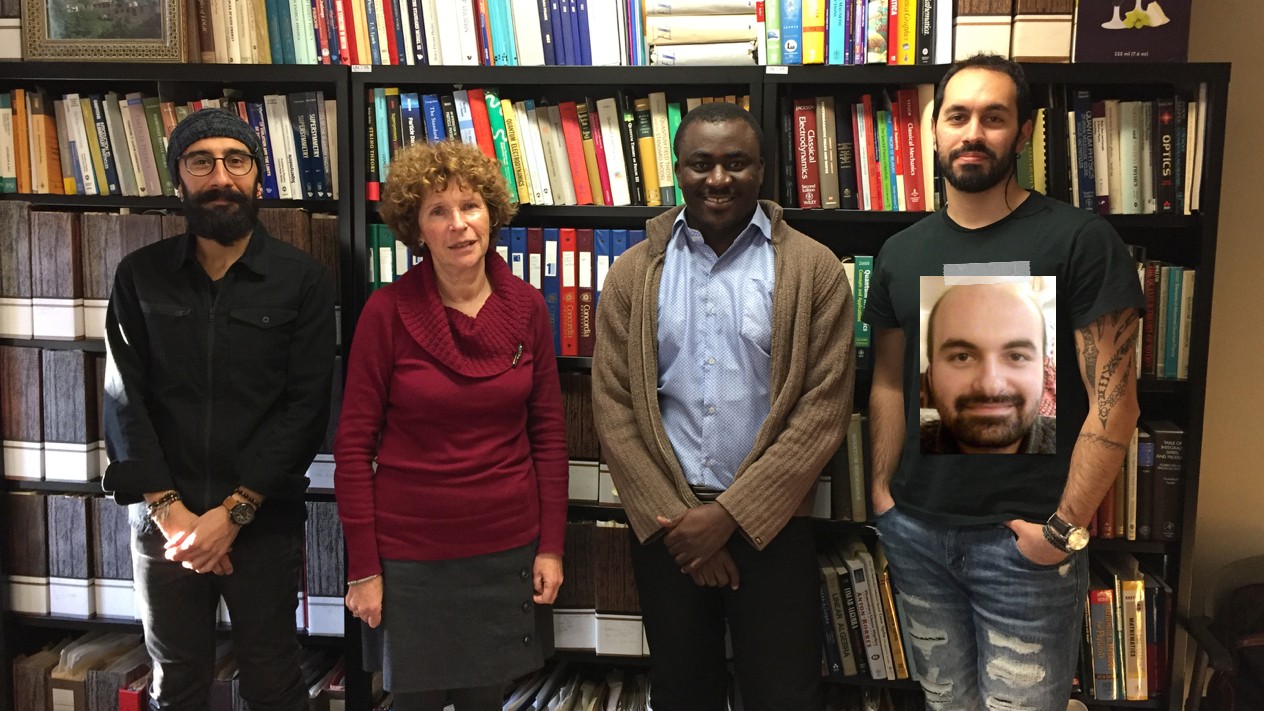 Mariana Frank research group members, 2019: (left to right) Kıvanç Çıngıloğlu, Dr. Mariana Frank, Eric Gyabeng Fuakye, Jack Araz and (inset) Özer Özdal.
Mariana Frank research group members, 2019: (left to right) Kıvanç Çıngıloğlu, Dr. Mariana Frank, Eric Gyabeng Fuakye, Jack Araz and (inset) Özer Özdal.
Physics at the Large Hadron Collider (LHC)
Some of our research projects are:
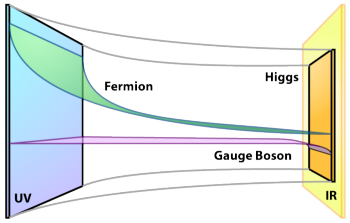
Introducing an extra space dimension and a warping of the space associated with it provides a viable explanation of why gravity is so weak at the Standard Model scale. Allowing the Standard Model particles to propagate in the extra dimension resolves fermion mass hierarchies and supresses flavour-changing currents.
In its original version of the model, the scale of this theory has to be high, precluding its observation at the LHC. We are exploring a version with a modified metric, which allows the scale to be lower and agrees with the data from the Higgs discovery.
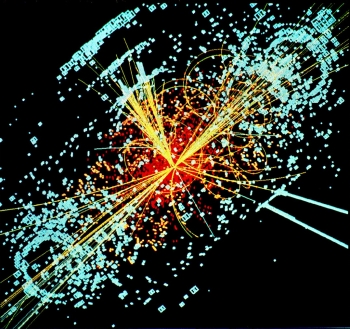
A spectacular signature of Physics Beyond the Standard Model would be the observation of a particle with different quantum numbers than the ones allowed for Standard Model particles: for instance a doubly-charged particle, or a particle with spin 2. We are trying to characterize such particles and indicate the most promising signals at the colliders.
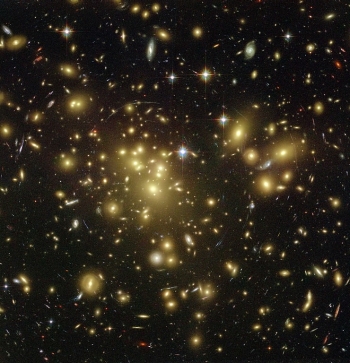
Dark Matter is non-baryonic matter that interacts only weakly. But what is it? Supersymmetry provides a natural candidate in the lightest supersymmetric particle, but what about other models? We propose possible candidates for dark matter and study their interactions and the interplay between LHC signals and dedicated Dark Matter direct and indirect detection experiments.
Principal investigator

Mariana Frank
Professor, Physics
Email: mariana.frank@concordia.ca
Collaborators
- Prof. Benjamin Fuks
Laboratoire de Physique Théorique et Hautes Énergies (LPTHE), UMR 7589, Sorbonne Université;
CNRS, 4 Place Jussieu, 75252 Pris Cedex 05, France;
Institut Universitaire de France, 103 boulevard Saint-Michel, 75005 Paris, France - Prof. Stefano Moretti
School of Physics and Astronomy, University of Southampton, Highfied, Southampton SO17 1BJ, United Kingdom - Prof. Katri Huitu
Department of Physics and Helsinki Institute of Physics, P. O. Box 64, FI-00014 University of Helsinki, Finland - Prof. Santosh Kumar Rai
Regional Centre for Accelerator-based Particle Physics, Harish-Chandra Research Institute, HBNI, Chhatnag Road, Jhusi, Prayagraj 211019, India - Prof. Poulose Poulose
Department of Physics, Indian Institute of Technology Guwahati, Assam 781039, India - Dr. Manuel Toharia
Department of Physics, Dawson College, 3040 Sherbrooke St W, Montreal, Qc, Canada H3Z 1A4 - Dr. Subhadeep Mondal
Department of Physics, Bennett University, Plot Nos 8-11, TechZone 2, Greater Noida, Uttar Pradesh 201310, India - Prof. Ismail Turan
Department of Physics, Middle East Technical University, TR06800 Ankara, Turkey - Dr. Levent Selbuz
Department of Engineering Physics, Ankara University, TR06100 Ankara, Turkey - Dr. Ipsita Saha
Kavli IPMU (WPI), UTIAS, University of Tokyo, Kashiwa, Chiba 277-8583, Japan. - Prof. Marc de Montigny
Campus Saint-Jean, University of Alberta, 8406 - 91 Street Edmonton AB T6C 4G9 - Dr. Pierre-Philippe Ouimet
Department of Physics, University of Regina, 3737 Wascana Pkwy, Regina, SK, Canada S4S 0A2
Current members
Research associates

Özer Özdal
Postdoctoral Fellow
Physics Beyond the Standard Model at the LHC
Email: ozerozdal@gmail.com
Students

Kıvanç Çıngıloğlu
Ph.D. student
Vector-like leptons at hadron colliders: characterization, masses, multilepton signals
Email: kivanc.cingiloglu@concordia.ca

Parham Dehghani
Ph.D. student
Superymmetric scenarios and R-symmetry breaking
Email: parham.dehghani@concordia.ca
Research gate profile

Tyrell Edward Umbach
M.Sc. student
Observing Dark Monopoles at the MoEDAL experiment
Email: tyrell.umbach@concordia.ca
Alumni
Postdoctoral fellows and research assistants
- Dr. Manuel Toharia (2010-2015). Now: Instructor at Dawson College, Montréal
- Dr. Levent Selbuz (2012-2013). Now: Assistant Professor at Ankara University
Graduate students
- Özer Özdal, Ph.D., 2020, Phenomenology of new physics beyond the Standard Model: signals of dark matter and new gauge bosons at colliders
- Jack Yakup Araz, Ph.D., 2020, Exploring beyond the minimal supersymmetric model scenarios with dark matter and collider signals
- Eric Gyabeng Fuakye, M.Sc., 2020, Higgs Boson Phenomenology in the Type II Two Higgs Doublet Model (2HDM)
- Ash Arsenault, M.Sc., 2017, Higgs vacuum stability in Standard Model extensions
- Sahar Bahrami, Ph.D., 2016, The Higgs Triplet Model: mixing in the neutral sector, vector-like fermions, and dark matter
- Nima Puortolami, Ph.D., 2015, Higgs Phenomenology in Warped Extra Dimensions
- Beste Korutlu, Ph.D., 2012, Higgs and Radion Phenomenology Beyond the Standard Model
- Alper Hayreter, Ph.D., 2011, Production and Decay of WR bosons in Left-Right Symmetric Models at the Tevatron and the LHC
- Lorric Ziegler, M.Sc., 2007, The Casimir Force in Randal Sundrum Models
- Artorix de la Cruz de Oña, M.Sc., 2005, CP phases in the chargino sector of the left right supersymmetric model
- Mario D'Amico, Ph.D., 2005, State-dependent classical potentials
- Pantelis Pnevmonidis, M.Sc., 2002, Feynman rules and static quantities of the charged vector bosons in a left-right supersymmetric extension of the standard model
- Stavros Antonopoulos, M.Sc. project, 1997, Specific decay widths in the left-right supersymmetric model
- Joachim Lindig
- Yuren Sun, M.Sc., 1992, ε'/ε in a pseudo manifestly left-right hand symmetric model
- Homayoun Hamidian, M.Sc. 1990, Pair production and decay of the Higgs fields in the left-right symmetric extension of the standard model
Undergraduate and summer students
- Jai Pimprikar (2019), NSERC USRA, Sterile neutrino as explanations for miniBOONe and LSND²
- Jun Hyung Bae (2018), B.Sc. honours thesis, Comparing Theoretical predictions of the Standard Model with the experimental data at the LHC
- George Williams (2018), B.Sc. specialization project, The Standard Model and Models with Extra Warped Space Dimensions
- Jai Pimprikar (2018) NSERC USRA, Standard Model as a Gauge Theory
- Amanda di Nitto (2018), B.Sc. honours thesis, Dark matter in Cosmology, Astrophysics and Particle Physics
- Andreas Sarchosis (2017), B.Sc. specialization project, Neutrino Physics Review
- Tyrell Edward Umbach (2016), B.Sc. specialization project, Scenarios of Physics Beyond the Standard Model
- Nedaa Asbah (2010), B.Sc. co-op summer project, Dark Matter in Particle Physics and Cosmology
A complete list of the publications can be found on INSPIRE.
- MoEDAL Collaboration, Magnetic Monopole Search with the Full MoEDAL Trapping Detector in 13 TeV pp Collisions Interpreted in Photon-Fusion and Drell-Yan Production. Phys. Rev. Lett. 123, 021802 (2019). doi:10.1103/PhysRevLett.123.021802
- Chatterjee, A., Frank, M., Fuks, B., Huitu, K., Mondal, S., Rai, S. K. & Waltari, H. Multileptonic signals of co-annihilating left-right supersymmetric dark matter. Phys. Rev. D 99, 035017 (2019). doi:10.1103/PhysRevD.99.035017
- Duan, G. H., Fan, X., Frank, M., Han, C. & Yang, J. M. A minimal U(1)′ extension of MSSM in light of the B decay anomaly. Physics Letters B 789, 54–58 (2019). doi:10.1016/j.physletb.2018.12.005
- Frank, M., Özdal, Ö. & Poulose, P. Relaxing LHC constraints on the WR mass. Phys. Rev. D 99, 035001 (2019). doi:10.1103/PhysRevD.99.035001
- Araz, J. Y., Banerjee, S., Frank, M., Fuks, B. & Goudelis, A. Dark matter and collider signals in an MSSM extension with vector-like multiplets. Phys. Rev. D 98, 115009 (2018). doi:10.1103/PhysRevD.98.115009
- Selbuz, L., Frank, M. & Turan, I. Higgs, chargino and neutralino mass spectra in RPV U(1)’. Il Nuovo Cimento C 40, 1–5 (2018). doi:10.1393/ncc/i2017-17198-x
- Araz, J. Y., Corcella, G., Frank, M. & Fuks, B. Loopholes in Z′ searches at the LHC: exploring supersymmetric and leptophobic scenarios. Journal of High Energy Physics 2018, 92 (2018). doi:10.1007/JHEP02(2018)092
- Frank, M. & Özdal, Ö. Exploring the supersymmetric U(1)B-L × U(1)R model with dark matter, muon g-2, and Z’ mass limits. Phys. Rev. D 97, 015012 (2018). doi:10.1103/PhysRevD.97.015012
- Araz, J. Y., Frank, M. & Fuks, B. Differentiating U(1)’ supersymmetric models with right sneutrino and neutralino dark matter. Phys. Rev. D 96, 015017 (2017). doi:10.1103/PhysRevD.96.015017
- Couture, G., Frank, M., Hamzaoui, C. & Toharia, M. Top and bottom partners, Higgs boson on the brane, and the tth signal. Phys. Rev. D 95, 095038 (2017). doi:10.1103/PhysRevD.95.095038
- Bahrami, S., Frank, M., Ghosh, D. K., Ghosh, N. & Saha, I. Dark matter and collider studies in the left-right symmetric model with vectorlike leptons. Phys. Rev. D 95, 095024 (2017). doi:10.1103/PhysRevD.95.095024
- Frank, M., Fuks, B., Huitu, K., Rai, S. K. & Waltari, H. Resonant slepton production and right sneutrino dark matter in left-right supersymmetry. Journal of High Energy Physics 2017, 15 (2017). doi:10.1007/JHEP05(2017)015


